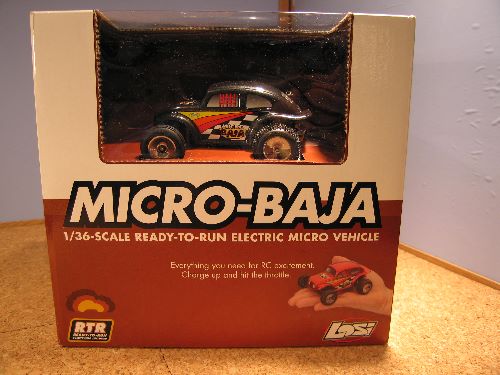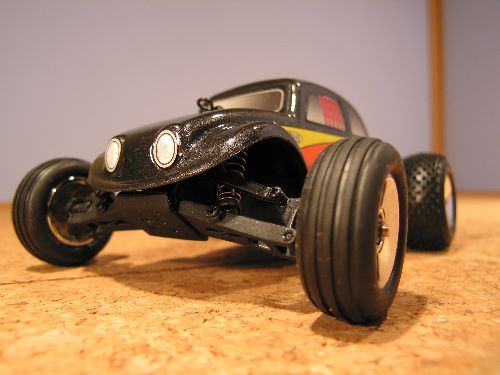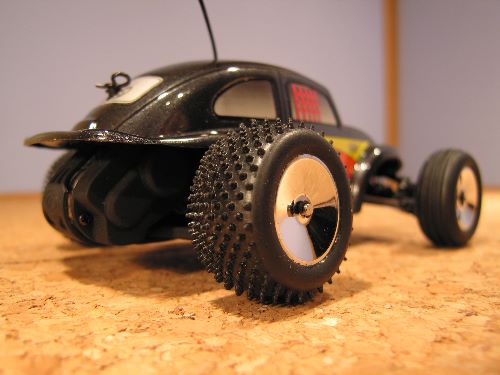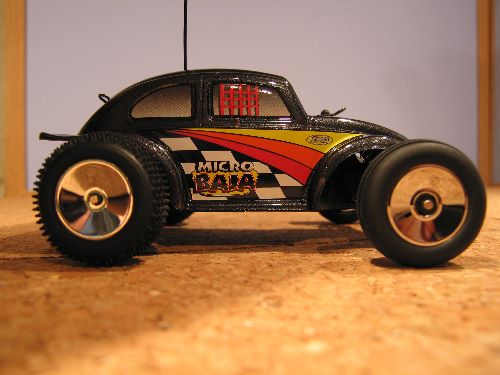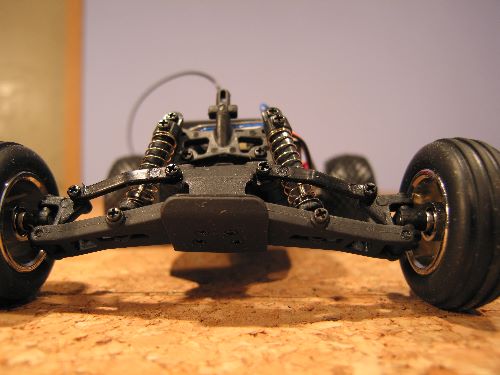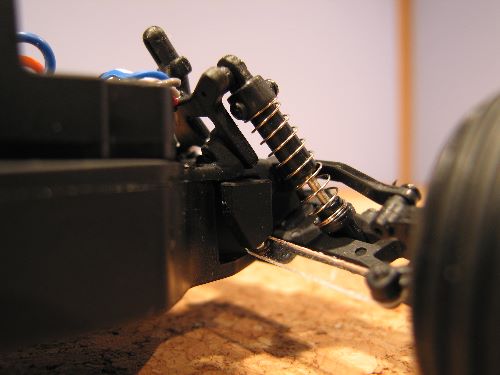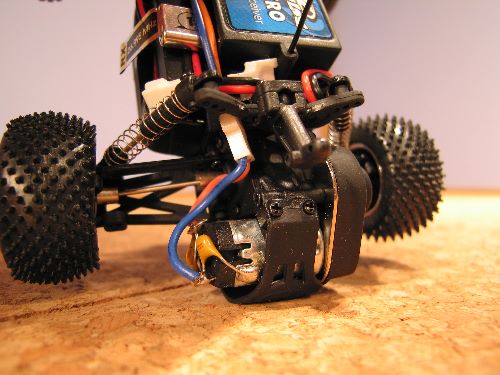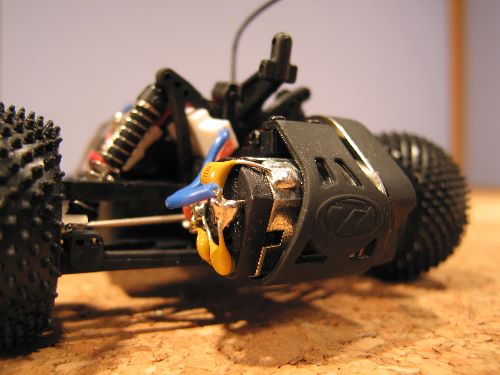
Team Losi Micro-T 1/36 Micro-Baja RTR
The Micro-Baja comes in at just under 5 inches long. Packed with a Ni-MH battery pack, independent suspension, differential-equipped transmission and a 27MHz radio system, the Micro-Baja has the speed and handling to tackle everything from the living room to your driveway. I purchased mine from www.atomicmods.com for $79.99 and $22 for shipping it arrived within two weeks and I was required to pay another $23 in GST and customs charges (at least our Canadian dollar was at par for a change) for a grand total of $125. As you can see from the photo below the package is quite small and I was eager to open it and get driving but I had to snap some photos first so enjoy them as it prevented me from enjoying my new toy for the duration of the photo taking session. I recently discovered that Discount hobbies in Orleans can order the Micro-T so if you want to avoid shipping fees check with your local hobby store to see if the can order it for you.
(Click on any photo to enlarge)
According to the literature I found on the Team Losi Micro-T the little buggy comes with a fairly decent set of specifications which are listed below for you consider.
- Fully independent suspension with friction dampers
- Differential-equipped transmission with adjustable slipper clutch
- Powerful, pre-installed micro motor
- Included Ni-MH battery pack with portable alkaline automatic peak charger
- Losi 27MHz AM radio system
- Electronic Speed Control with Reverse
- Micro narrow ribbed tires (front), Micro step pins (rear) mounted on chrome dish wheels
- Includes 8 AA heavy-duty batteries for transmitter
- Includes 8 AA alkaline batteries for charger
As you can see in the photo above the rather small package contains a controller, charger, manual and enough batteries to power everything, you can purchase a separate AC charger for the Micro-T and I can see where a battery powered charger makes sense if an AC outlet is not present but at around 22 minutes to charge the battery it doesn't seem that practical to have a battery powered charger.
The rather interesting thing is that other battery powered RC chargers such as the one in the Epoch or Miroz GT only take 2-3 minutes to charge and the Epoch uses a 3.6V 120mAh NiMH battery which is not far from the included 4.8V 150mAh NiMH that comes with the Micro-T, so what exactly does the extra 20 minutes on the charger get you, well not extra run-time as you will see in the charging section further down as the Micro-T's run time is a paltry 5-7 minutes per charge (depending on batteries used).
Team Losi Micro-T Specifications:
- Scale:1/36
- Length:4.5 in (114mm)
- Width:3.5 in (89mm)
- Wheelbase:3 in (76mm)
- Weight:3.4 oz (96g)
- Drive Train:3-gear transmission w/ gear diff and slipper
- Batteries:4.8V 150mAh NiMH (included)
- Wheel Size:0.75 in (19mm) diameter
- Shock Type:Coil-over friction dampers
- Ball Bearings:BB- Equipped Transmission
Just a note the 114mm mentioned in the specifications are not exactly right depending on how you measure the Micro-T if you include the body it's closer to 120mm but it's still a mighty small R/C so I'm not going to fault the measurements.
The specifications mention Ball bearings but these are only present in the transmission as expected you can purchase ball bearing for the wheels if you so desire. You can see the wide stance of the Micro-T and the design of the front suspension means the wheels move inwards which is important because when you run into an obstacle it makes for a very forgiving front-end that seems to be able to take a lot of abuse from all those smacks into the wall I managed to put the little guy through.
I did notice that the rear seemed to be drooping way to much out of the box compared to the front suspension this could be from sitting in the box over an extended period or the way it was designed but I was not happy with the suspension in the rear as it bottomed out way to easy so I used a small zip-tie to boost the springs by placing them around the shock bodies this seems to have helped as the handling and suspension are vastly improved. You can see where I installed the zip-ties in the photos related to the transmission further below.
I cheated a little for this photo as I was pulling upward on the antenna to try and get a photo of the Micro-T without the sagging rear.
Obviously from the photo above you can see that the Mico-T has a decent suspension travel
The front Suspension is well designed with nice solid swing-arms and the coil-over friction dampers (shocks) that work reasonably well but do give a rather bouncy ride, of course oil dampened shocks are available as another upgrade but the stock ones work well. My advice would be if you intend to take a lot of jumps then invest in the better shocks as the stock ones are not adequate but for driving over the bumps and cracks found in the average drive-way the stock shocks are fine.
Here is a better view of the coil-over friction dampened shocks I originally assumed the two screws at the top of the shock were some kind of adjustment but I was wrong. Note the clear tie-rods these are great as they have some flex to them so when you hit that wall (trust me you will) they help along with the suspension to flex and avoid breakage.
The chassis as seen from above offers a clear view of the ESC (Electronic Speed Controller) the entire chassis is made from a rather tough plastic and the Micro-T uses 'Crystals' to set the frequency used, mine was 26.995Mhz and I actually swapped some crystals from my other R/C's and they worked fine with the Micro-T so you can swap controllers and crystals without any issues.
Here we have the unusual 'Micro electric' motor used to power the Micro-T I say that only because this motor seems to be a custom size and my efforts to get any information on the type and size of motor have not met with many results but I did find some other interesting information on the motor which you can read further down right now I want to talk about the Transmission used on the Micro-T



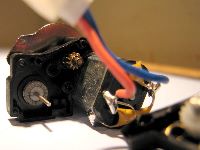
The Micro-T's transmission is quite amazing given the small scale and it uses quite a few gears but that being said my transmission seemed to be rather 'sticky' so I took it apart and checked everything. It seemed fine so I reassembled it and tested it again, it was still 'sticky' so I loosened the screws holding the transmission together and tried again this did the trick until I replaced the slipper/drive gear cover. I then found the car struggling once again so I removed the cover and everything seemed fine. I fiddled and eventually figured out the cover when screwed down was rubbing on the slipper gear and causing the binding problem so I filed and sanded the inside of the cover where it was rubbing and after re-installing the cover I was pleased to see a very responsive non 'sticky' transmission.
The motor is known as a 'Hot' motor which means it can pull a significant of power from the electronics and that means it will heat-up much faster as well. How much current you ask well I've read that the motor draws 500mA at 4.8V with no load, it could easily draw 1.2 - 2.5A or more. In fact if you throttle up to fast from a stand-still the Micro-T will pull a wheelie I had to adjust the slipper clutch to not catch so easy as I was pulling wheelie's constantly and the load would cause the ESC (Electronic Speed Control) to shut-down (using LiPo battery) which required me to switch the power off/on to reset the ESC. Full throttle is possible once it gets rolling but you better be outside or in a very large area as I have mentioned this little rocket will be gone!.
I liked how the Micro-T uses the body-clips but darn those clips are a real pain for those of us with large fingers I had to use long nose pliers to install and remove them, not a big issue until you realize in order to charge the battery you need to remove the body and disconnect the battery lead from the ESC to attach it to the charger. This is where a charge connecter built into the bottom of the chassis would have been really nice.
The rear sag I was referring to is more evident here as you can see the rear tires sit at an angle in fact if you looked at the Micro-T from directly behind the drive axles are pointing slightly upwards to the wheels after I added the zip-ties to the shock towers the rear raised up close to 10mm.
Team Losi Micro-T (1:36) compared to the Team Losi Mini-LST (1:18) and the Microz GT (1:50)
The Losi Micro-T has direct charging adapter which you can purchase through a Team Losi dealer to avoid having to use the portable battery charger. I decided it due to shipping costs it was cheaper to wire a DC adapter directly to the battery terminal wires. I used a 12V DC adapter rated at 500mA and while the approximate 20 minute charge cycle is annoying it works fine. If you allow a 5-8 minute cool down between charges you can charge multiple times the chart below shows the difference in run rime compared to the amount of charges used. The Micro-T uses a NiMh (Nickel-metal Hydride) battery rated at 4.8 Volts and 150mah (mAh stands for Milliamp Hour, a technical term for how much power a particular battery will hold)
| *500mA 12Volt (DC) | Run-Time |
| Single charge | 3 min 30 secs |
| Double charge | 7 minutes |
| Triple charge | 7 minutes |
* I wired a 500mA DC adapter directly to the battery terminals to ensure battery life would not effect the tests and I have done them a few times and averaged the times to arrive at the table above.
The Range is quite good and the stock Micro-T with stock battery is good for about 19Kph (12Mph) swapping out the stock battery for the LiPo brings the speed to about 35Kph (22Mph) If you swap in the Atomic micro BB motor with the LiPo you can expect to get 40Kph (25Mph). Remember if driving indoors these speeds mean you have very little time before hitting a wall so drive carefully.
The steering servo is very quick and responsive and the Micro-T is very controllable even on slick tiles and wood floors thanks to the soft rubber wheels, but on a carpet or pavement the Micro-T really holds the road and you need to be more subtle with the controls.
The Micro-T is well built and with a full assortment of possible upgrades can be transformed into quite the performer but the best part is that even a stock Micro-T is a blast to drive. If your looking for a R/C that can be used indoors with no need for a track and you wish to get a little creative with possible terrain the Micro-t will tackle pretty much anything you can throw in it's path and when you want take the Micro-T outdoors if you so desire it will exceed you expectations again. The Micro-T is a blast to drive, sturdy enough to handle the occasional wall and can be fully upgraded thanks to the host of upgrades but it's not suitable for drifting as it sticks to the road a little to well....
The only issue I had was the screws used to hold everything together are really small and the amount of types and sizes used on the Micro-T is quite a pain to keep track of so be warned when taking anything apart on the Micro-T make sure you mark where the screws go as you'll be shaking your head later when putting it all back together.
I have created a little video of the Micro-T and various R/C cars running on my home-made track you can view a 640x480 or a 320x240 version by clicking the links below. I you would like to learn more about building a track of your own click Here
- R/C cars in action 320x240 (4.2 Mb .wmv format)
- R/C cars in action 640x480 (8.4 Mb .wmv format)
